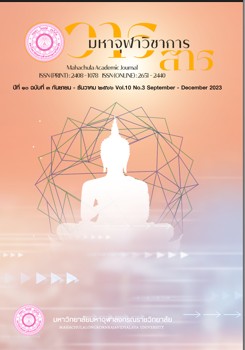An Analytical Study of Buddha's saying: If the Sangha wants to abolish some minor rules, it may
Main Article Content
Abstract
This academic article has the objective of analyzing Buddha's saying in the Mahāparinibbanasutta: If the Sangha wants to abolish some minor rules, it may. This study was conducted by considering scriptures that directly describe Buddha's saying and by considering the principles in the Tripitaka. The study found 1) The Buddha did not speak to allow the monks to abolish their minor rules, but he spoke to test the minds of the monks in Buddhism. This Buddha's saying should not be used as a reason or an excuse for abolishing some minor rules because he established rules to prevent monks from misbehaving. Therefore, having the idea to abolish some minor rules by using mentioned Buddha's saying as a reason is equivalent to destroying the principles of Buddhism.
Article Details

This work is licensed under a Creative Commons Attribution-NonCommercial-NoDerivatives 4.0 International License.
References
พระพรหมคุณาภรณ์ (ป. อ. ปยุตฺโต). ตอบ ดร.มาร์ติน: พุทธวินัย ถึง ภิกษุณี. พิมพ์ครั้งที่ ๔. ม.ป.ท., ๒๕๕๕.
พระพุทธโฆสเถระ. คัมภีร์วิสุทธิมรรค. แปลโดย สมเด็จพุฒาจารย์ (อาจ อาสภมหาเถระ). พิมพ์ครั้งที่ ๑๐. กรุงเทพมหานคร: บริษัท ธนาเพรส จำกัด, ๒๕๕๔.
พระมหาดาวสยาม วชิรปัญโญ. ประวัติศาสตร์พระพุทธศาสนาในอินเดีย. พิมพ์ครั้งที่ ๔. กรุงเทพมหานคร: บริษัท เอกพิมพ์ไท จำกัด, ๒๕๕๗.
พระมหาธิติพงษ์ อุตฺตมปญฺโญ. ไวยากรณ์บาลีเบื้องต้น. พิมพ์ครั้งที่ ๕. กรุงเทพมหานคร: ประยูรศาส์น การพิมพ์, ๒๕๖๐.
พระมหาสมบูรณ์ วุฑฺฒิกโร. การตีความในพระพุทธศาสนา. กรุงเทพมหานคร: โรงพิมพ์เซ็นจูรี่, ๒๕๖๑.
มหาจุฬาลงกรณราชวิทยาลัย. พระไตรปิฎกภาษาไทย ฉบับมหาจุฬาลงกรณราชวิทยาลัย.กรุงเทพมหานคร: โรงพิมพ์มหาจุฬาลงกรณราชวิทยาลัย, ๒๕๓๙.
______. สารตฺถทีปนีฏีกา (ตติโย ภาโค). กรุงเทพมหานคร: โรงพิมพ์วิญญาณ, ๒๕๓๘.
มหาจุฬาลงกรณราชวิทยาลัย. อรรถกถาภาษาไทย พระวินัยปิฎก สมันตปาสาทิกา ภาค ๑. พิมพ์ครั้งที่ ๒ กรุงเทพมหานคร: โรงพิมพ์มหาจุฬาลงกรณราชวิทยาลัย, ๒๕๖๐.
______. อรรถกถาภาษาไทย พระวินัยปิฎก สมันตปาสาทิกา ภาค ๒. พิมพ์ครั้งที่ ๒ กรุงเทพมหานคร: โรงพิมพ์มหาจุฬาลงกรณราชวิทยาลัย, ๒๕๖๐.
______. อรรถกถาภาษาไทย พระสุตตันตปิฎก ทีฆนิกาย มหาวรรค. พิมพ์ครั้งที่ ๒. กรุงเทพมหานคร: โรงพิมพ์มหาจุฬาลงกรณราชวิทยาลัย, ๒๕๕๙.
______. อรรถกถาภาษาไทย พระสุตตันตปิฎก มัชฌิมนิกาย มูลปัณณาสก์ ปปัญจสูทนี ภาค ๒. พิมพ์ครั้งที่ ๒. กรุงเทพมหานคร: โรงพิมพ์มหาจุฬาลงกรณราชวิทยาลัย, ๒๕๕๒.
______. คัมภีร์มิลินทปัญหาภาษาไทย. กรุงเทพมหานคร: โรงพิมพ์มหาจุฬาลงกรณราชวิทยาลัย, ๒๕๕๙.
สมเด็จพระพุทธโฆษาจารย์ (ป. อ. ปยุตโต). พจนานุกรมพุทธศาสตร์ ฉบับประมวลธรรม. พิมพ์ครั้งที่ ๓๔. (กรุงเทพมหานคร: โรงพิมพ์พระพุทธศาสนาของธรรมสภา, ๒๕๕๙.
Assistant Professor Ven. Guang Xing. “The Questions of Lesser and Minor Rules”. Journal of International Buddhist Studies (JIBS). Vol 2 (December 2010).
Bhikkhu Khantipāl.The Buddhist Monk's Discipline Some Points Explained for Laypeople. Kandy Sri Lanka: Buddhist Publication Society, 1984.
Jotiya Dhirasekera. Buddhist Monastic Discipline. Colombo: M.D. Gunasena & Co, 1982.
Richard F. Gombrich. Theravāda Buddhism. 2 ed. London and New York: Routledge, 2006.
Sanu Mahatthanadull. “Bhikkhu Pātimokkha: the Fundamental Precepts and their Number of Rules”. Teaching Document, International Buddhist Studies College: Mahachulalongkornrajavidyalaya University, 2014.
ธรรมปาลา. “เรื่อง เงินทอง กับ ทางออก ของคณะสงฆ์ไทย”. ประชาไท. [ออนไลน์]. แหล่งที่มา: https://prachatai.com/journal [๒๘ กรกฎาคม ๒๕๖๕].


